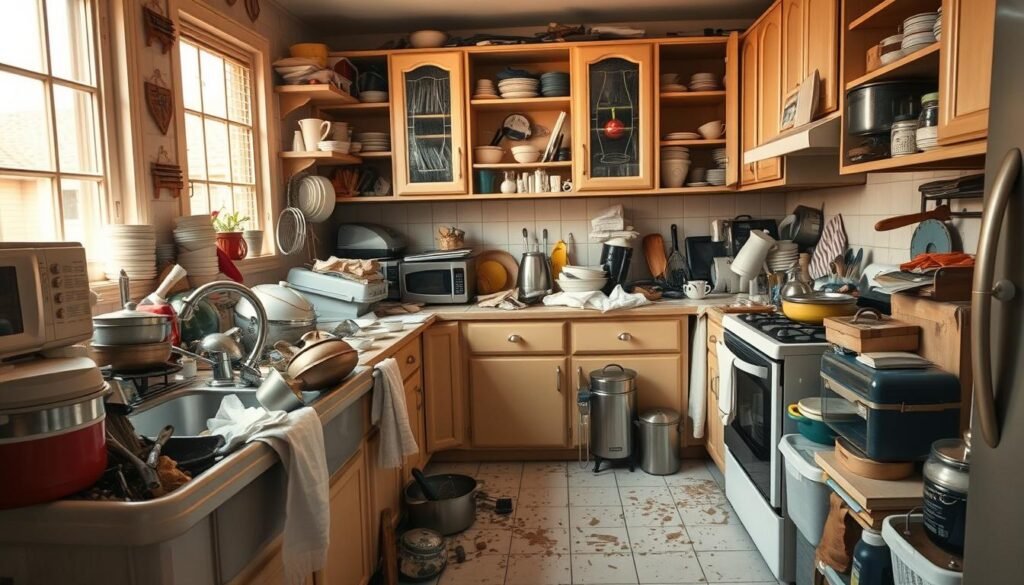
As a busy home cook or professional chef, a well-organized kitchen space is essential for efficiency and enjoyment. By simplifying your kitchen, you’ll not only reduce stress but also make cooking more enjoyable and improve your overall household management.
In this guide, we’ll walk you through a step-by-step process to transform your kitchen from chaotic to calm, creating a space that works for your lifestyle.
Key Takeaways
- Discover how clutter affects your cooking experience and household management.
- Learn a simple, step-by-step process to declutter your kitchen.
- Find practical tips to maintain your newly organized kitchen space.
- Maximize your kitchen’s potential, regardless of its size.
- Rediscover the joy of cooking in a calm, organized environment.
Why a Clutter-Free Kitchen Matters
A clutter-free kitchen is more than just a tidy space; it’s the heart of a stress-free home. When your kitchen is organized, you can enjoy a more efficient cooking experience and a more pleasant environment for you and your family.
The Benefits of Kitchen Decluttering
Decluttering your kitchen offers numerous benefits, including easier meal planning and faster food preparation. With a clutter-free kitchen, you’ll be able to quickly find the items you need, saving you time and reducing stress. This organized space allows for more efficient use of your time, making cooking and meal prep more enjoyable.
How Clutter Affects Your Cooking Experience
Clutter in the kitchen can significantly impact your cooking experience. When counters and cabinets are overflowing with items, it wastes precious time searching for ingredients and tools. A decluttered kitchen transforms this experience by making meal preparation more efficient, allowing you to focus on cooking rather than searching.
| Benefits | Cluttered Kitchen | Clutter-Free Kitchen |
|---|---|---|
| Meal Planning | Difficult to find ingredients | Efficient and organized |
| Cooking Time | Wastes time searching for tools | Saves time, faster prep |
| Stress Levels | Increased stress | Reduced stress |
By maintaining a clutter-free kitchen, you create a space that is not only easier to clean and maintain but also more enjoyable for cooking and spending time with your family. This, in turn, contributes to a more peaceful home atmosphere.
Preparing for Your Kitchen Decluttering Project
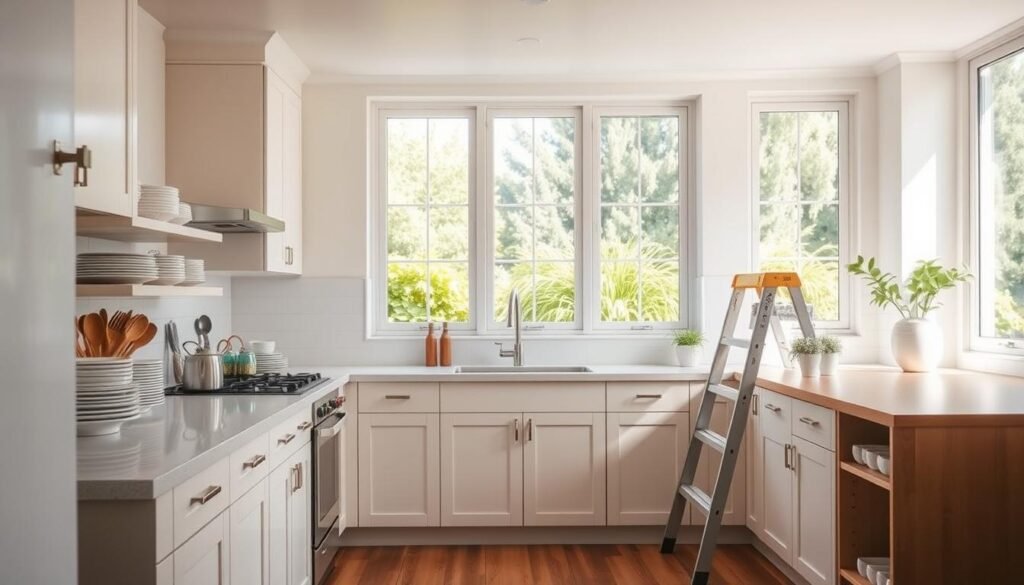
The key to a successful kitchen decluttering project lies in the preparation; let’s explore how to get started. To declutter your kitchen efficiently, you need to assess your current situation and plan your approach. This initial step will help you identify the areas that need the most attention and create a roadmap for your decluttering journey.
Assessing Your Current Kitchen Space
Begin by taking a good look around your kitchen. Identify the areas that are particularly cluttered or disorganized. Ask yourself, “What are the main types of clutter in my kitchen?” and “What areas are not being used to their full potential?” This assessment will help you understand what needs to be done and how you can better utilize your kitchen space once it’s decluttered.
Creating a Decluttering Plan
Creating a realistic decluttering plan is essential to avoid feeling overwhelmed. Consider breaking down your kitchen decluttering into manageable sections: start with countertops, then move on to upper cabinets, lower cabinets, drawers, and finally the pantry. This step-by-step approach will make the task less daunting and more achievable.
Gathering Necessary Supplies
Before you begin, gather all the necessary supplies. You’ll need boxes for donations, trash bags, cleaning supplies, and perhaps some basic organizing tools like drawer dividers or bins. Having everything you need at hand will make the decluttering process smoother and more efficient.
| Supply | Purpose |
|---|---|
| Boxes | For donations and items to be stored |
| Trash Bags | For disposing of unwanted items |
| Cleaning Supplies | For cleaning surfaces and items |
| Drawer Dividers/Bins | For organizing utensils and kitchen tools |
The Kitchen Decluttering Process: Step-by-Step
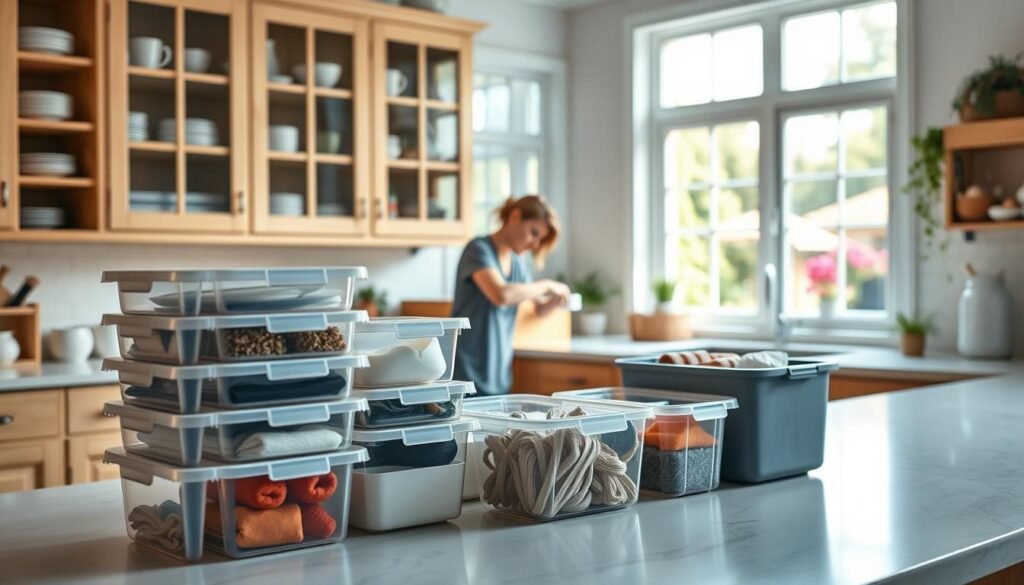
Starting your kitchen decluttering journey can feel overwhelming, but breaking it down into manageable steps makes all the difference. By following a systematic approach, you’ll be able to transform your kitchen into a clutter-free zone that enhances your cooking experience.
Step 1: Empty and Sort Items by Category
The most effective way to declutter your kitchen is to work methodically by category rather than by location. This helps you see exactly how many similar items you own. Start by completely emptying one category at a time, such as mugs, pots and pans, or food storage containers, and place everything on a clear counter or table where you can see it all. This visual representation will help you decide what to keep and what to let go of.
Step 2: Decision-Making Questions to Ask Yourself
As you sort through your kitchen items, ask yourself practical questions to make informed decisions. Consider: When was the last time I used this? Does it make my life significantly easier in the kitchen? Do I have something else that can do the same thing? Be honest with yourself, and you’ll be able to make swift decisions about what stays and what goes.
| Question | Purpose |
|---|---|
| When was the last time I used this? | Helps determine if the item is still useful. |
| Does it make my life easier? | Assesses the item’s functionality. |
| Do I have duplicates? | Identifies unnecessary duplicates. |
Step 3: Create Keep, Donate, and Discard Piles
As you continue sorting, create three distinct piles: items to keep, things to donate, and stuff to discard. Be ruthless with the latter two categories! For items you’re on the fence about, consider whether you’d buy the same thing again today. If not, it’s a good candidate for donation. Remember, getting rid of kitchen stuff doesn’t mean you’ve wasted money; it means you’re making room for the things you actually use and enjoy.
Optimizing Storage – Creating Organized Kitchen with Storage Solutions
Tackling Countertops and Visible Spaces
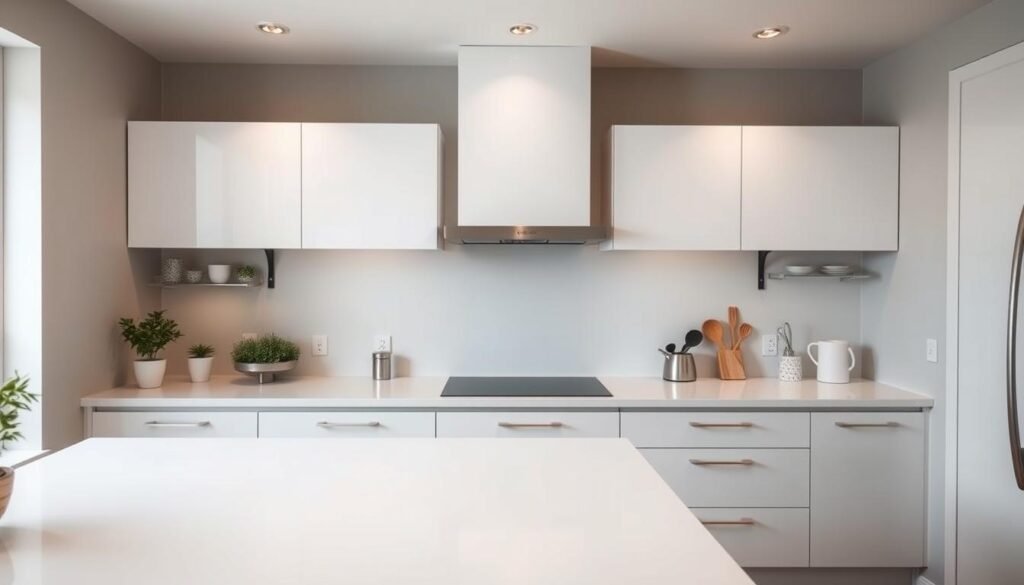
Cluttered countertops can make even the most beautiful kitchen look disorganized and chaotic. To regain control, start by breaking down the task into smaller, manageable chunks. Focus on one zone or category of clutter at a time to avoid feeling overwhelmed.
Clearing Paper Clutter and Miscellaneous Items
Begin by removing everything from your counters that doesn’t belong in the kitchen. Mail, keys, and kids’ homework should have designated homes elsewhere. Sort papers into three categories: keep, shred, or recycle. Be ruthless – if you don’t need it, it’s clutter.
Evaluating Small Appliances and Décor
Assess your small appliances and decide which ones deserve counter space. Only daily-use items like coffee makers should stay out. Store occasional-use appliances in cabinets to free up valuable space. Consider the impact of decorative items on your counter functionality – too many can collect dust and reduce workspace.
Creating a Daily Reset Routine
Implement a daily “counter reset” routine where everyone in the household helps return items to their proper places before bedtime. This simple habit can prevent clutter from accumulating and keep your kitchen organized. By dedicating just a few minutes each day to this task, you’ll maintain your newly decluttered counters.
| Decluttering Task | Action | Benefit |
|---|---|---|
| Clear Paper Clutter | Sort into keep, shred, or recycle | Reduces visual clutter |
| Evaluate Small Appliances | Store infrequently used appliances | Creates more counter space |
| Reset Counters Daily | Return items to their homes | Maintains organization |
Decluttering Kitchen Cabinets and Drawers
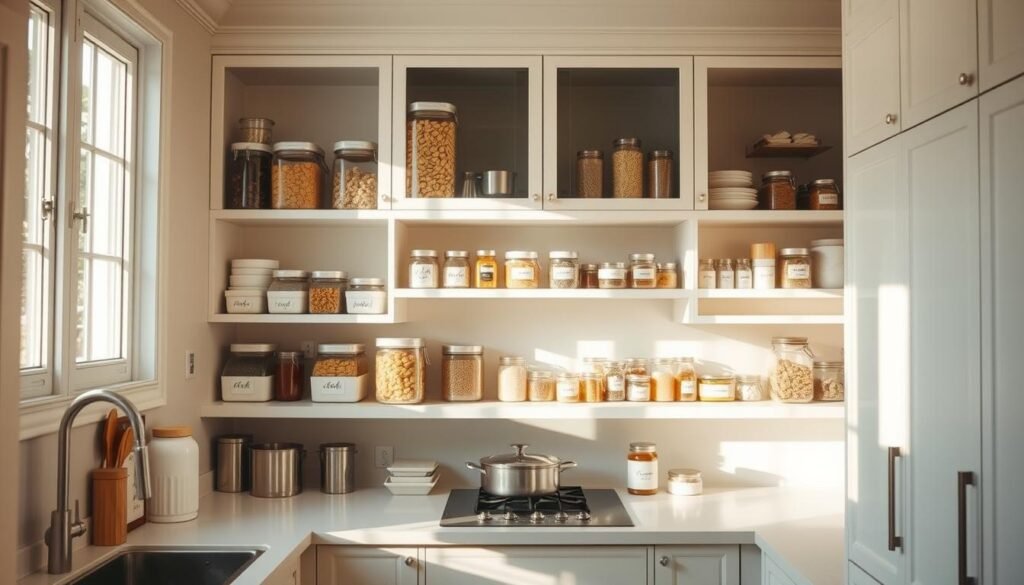
Tackling the clutter in your kitchen cabinets and drawers can feel overwhelming, but with a clear plan, you can achieve a more organized kitchen. Cabinets and drawers can quickly become cluttered without regular purging and proper organization. Here’s how to clear out the clutter and establish order in your kitchen storage spaces.
Organizing Cookware and Bakeware
Start by completely emptying one cabinet or drawer at a time, grouping similar items together so you can see exactly how many pots, pans, or baking sheets you own. Be honest about what you actually use; most home cooks only regularly use a few key pieces. Consider donating specialty items that rarely see the light of day.
Managing Food Storage Containers
The food storage container cabinet is often the most chaotic. Match all containers with their lids, recycle any mismatched pieces, and consider investing in a uniform set that stacks neatly. This will help you maintain a clutter-free storage system and make the most of your cabinet space.
Streamlining Utensils and Gadgets
Drawer organizers are worth their weight in gold for keeping utensils and gadgets in order. Measure your drawers before purchasing and opt for adjustable ones when possible. Consider the “one in, one out” rule for kitchen tools going forward to prevent drawers from becoming overcrowded again.
By following these steps and maintaining your newly organized cabinets and drawers, you’ll find that your kitchen becomes a more enjoyable and efficient space. Don’t forget to address the dreaded “junk drawer” by sorting through it completely and creating dividers for categories like batteries, pens, and small tools.
Pantry Organization and Food Storage
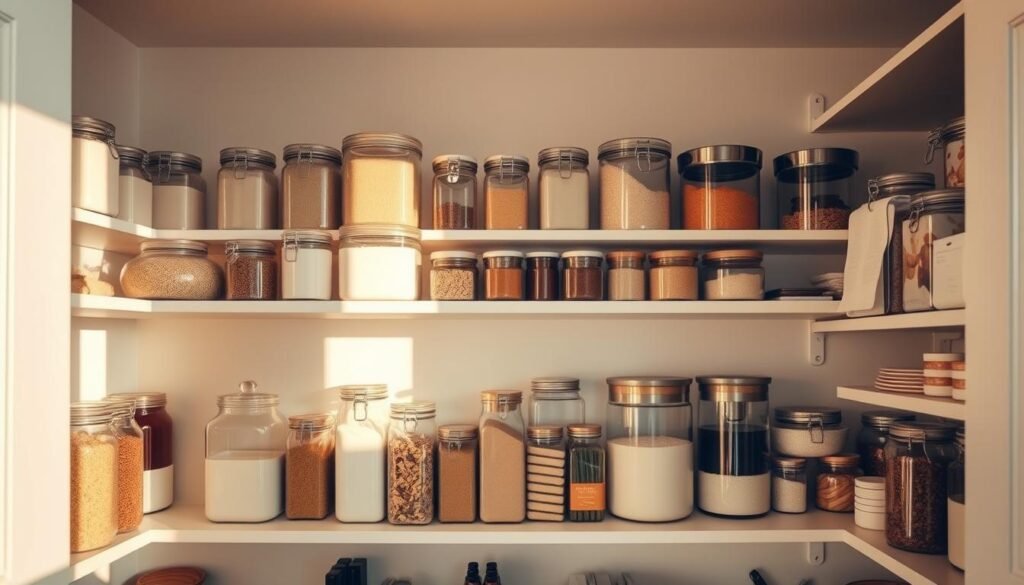
Pantry organization is more than just tidying up; it’s about creating a system that works for you. A well-organized pantry can save you time and money by reducing food waste and making meal planning more efficient.
Sorting and Categorizing Food Items
Start by removing everything from your pantry shelves and grouping similar items together. You’ll likely be surprised by how many duplicate items you’ve been storing. Create logical categories for your food items based on how you cook, such as baking supplies, breakfast items, snacks, canned goods, pasta, and grains.
Implementing Storage Solutions
Clear storage containers are not just visually appealing; they’re also practical for keeping items like flour, sugar, and cereals fresh longer. Consider implementing a “first in, first out” rotation system to minimize food waste. Label everything, especially if you transfer items to storage containers, to ensure you can easily identify what’s inside.
Creating a Sustainable Food Inventory System
Create a simple inventory system that works for your cooking style. Some people benefit from a running grocery list on the pantry door, while others prefer digital apps to track what they have. Don’t forget to measure your shelves before purchasing storage bins or organizers to ensure they fit perfectly.
| Category | Storage Solution | Benefits |
|---|---|---|
| Baking Supplies | Clear Containers | Keeps ingredients fresh, easy to identify |
| Canned Goods | Adjustable Shelves | Maximizes storage space, easy access |
| Snacks | Baskets or Bins | Convenient, keeps snacks visible |
By following these steps, you can create a pantry that is not only organized but also functional and sustainable, making your kitchen a more enjoyable space to cook and prepare meals.
Smart Organization Solutions After Decluttering
The decluttering process is just the beginning – now it’s time to organize your kitchen for maximum efficiency. With your kitchen now free from clutter, implementing smart organization systems will help maintain your newly organized space.
Space-Maximizing Storage Ideas
Maximizing your kitchen’s storage space is crucial for maintaining organization. To achieve this, consider utilizing vertical storage options such as stackable shelves inside cabinets or wall-mounted magnetic strips for knives. Drawer dividers and organizers are also game-changers for keeping utensils and small items neatly arranged.
Organizing by Frequency of Use
Organizing your kitchen by frequency of use ensures that your most-used items are easily accessible. Place daily-use items in prime locations, such as the front of drawers or middle shelves of cabinets. For example, keep your most-used cooking utensils in a drawer next to the stove.
Labeling Systems That Work
A clear and consistent labeling system is essential for maintaining your kitchen’s organization. Use a label maker to identify contents of pantry bins, spice jars, and other containers. This simple step ensures that everyone in the household can maintain the organization system.
| Organization Tip | Benefit |
|---|---|
| Use vertical storage | Maximizes space in cabinets and on walls |
| Organize by frequency of use | Places most-used items in easy-to-reach locations |
| Implement a labeling system | Helps maintain organization and clarity |
Conclusion: Maintaining Your Newly Decluttered Kitchen
Maintaining a decluttered kitchen is a journey, not a destination, and it starts with simple daily habits. To keep your kitchen organized, establish a routine of tidying your countertops daily, spending just 5-10 minutes in the morning and evening.
Make it a habit to put things away after you’re done using them. Be mindful of new kitchen gadgets; ask yourself if they’re truly necessary before making a purchase. Regular mini-decluttering sessions will also help maintain your space.
- Implement a “one in, one out” rule to maintain balance.
- Get your family involved to ensure everyone knows where things belong.
- Create a daily reset routine to keep counters clear and dishes put away.
By following these tips, you’ll not only maintain your decluttered kitchen but also enjoy a more peaceful cooking experience. Remember, it’s about creating systems that work for your family’s lifestyle.
FAQ
How do I get started with organizing my kitchen space?
Begin by assessing your current kitchen layout and identifying areas that need improvement. Take note of the items you use daily and those that are taking up unnecessary space.
What’s the best way to sort through my kitchen items?
Sort items into categories, such as bakeware, cookware, and utensils. Then, ask yourself decision-making questions like “When was the last time I used this item?” or “Does it have sentimental value?” to help you decide what to keep and what to discard.
How can I maximize storage in my kitchen?
Consider using space-maximizing storage solutions like stackable containers, adjustable shelves, and drawer organizers. You can also optimize your cabinet space by installing dividers or baskets.
What’s the best way to maintain my newly decluttered kitchen?
Create a daily reset routine to keep your kitchen counters and sink area clear. Set aside time each week to maintain your organized systems and make adjustments as needed.
How can I keep my pantry organized?
Implement a categorization system for your food items, and use storage containers or baskets to keep similar items together. Consider labeling your storage solutions to ensure easy access.
What’s the benefit of organizing items by frequency of use?
Organizing items by frequency of use ensures that your most-used items are easily accessible, making meal prep and cooking more efficient. It also helps to reduce clutter by storing less frequently used items out of the way.
How can I make the most of my kitchen drawers?
Use drawer organizers or dividers to separate utensils, gadgets, and other items. Consider using inserts or trays to maximize storage and keep items from getting jumbled.
